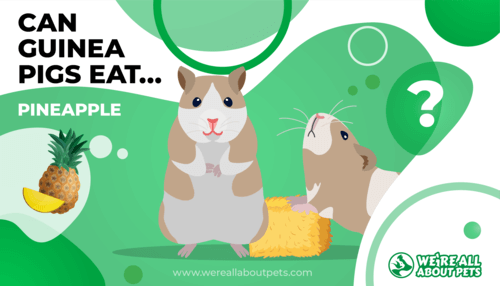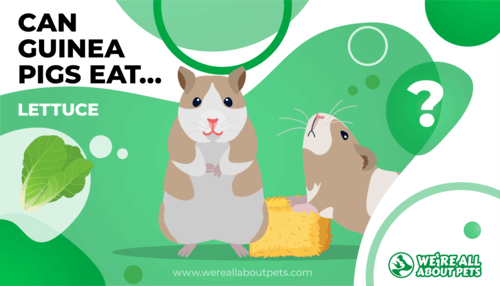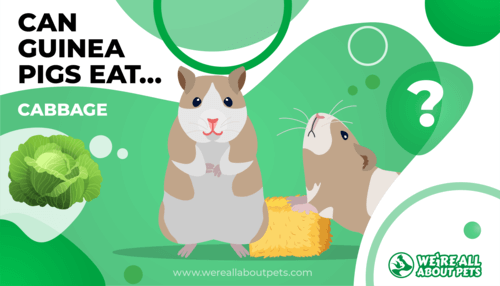Can Guinea Pigs Eat Green Beans?
This page contains affiliate links. We may earn money or products from the companies mentioned in this post through our independently chosen links, which earn us a commission. Learn More
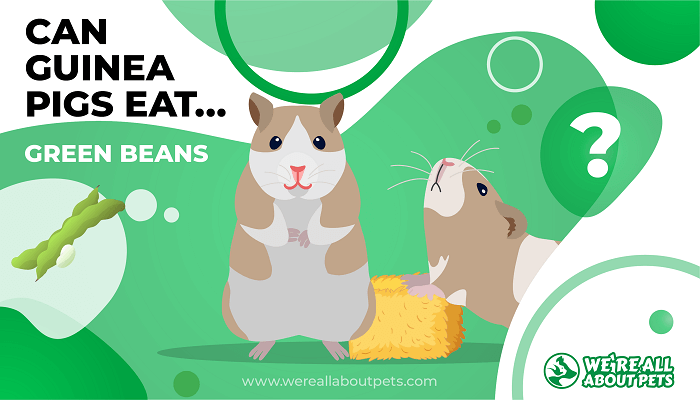
Mild-tasting, satisfying, and versatile, green beans are fantastic all by themselves, in soups and stews, and in (what else?) green bean casserole! If you’ve got some fresh, crisp green beans on hand, you’re probably wondering whether you can share them with your cavy.
We get it, you’ve got questions! Can guinea pigs have green beans? If so, how many can they eat and how often can they have this yummy treat?
Lucky for you (and your cavy!) we’ve got answers, too. Here’s the first one: Yes, guinea pigs can eat green beans!
Green Beans Nutrition Stats
Green beans make a fantastic side dish for just about any meal. They’re low in calories before you dress them up with extras, too!
In a one-cup serving of fresh green beans, you’ll get about:
- 34 calories
- 8 g carbohydrates
- 7 g fiber
- 2 g protein
- .1 g fat
Green Beans Nutritional Facts
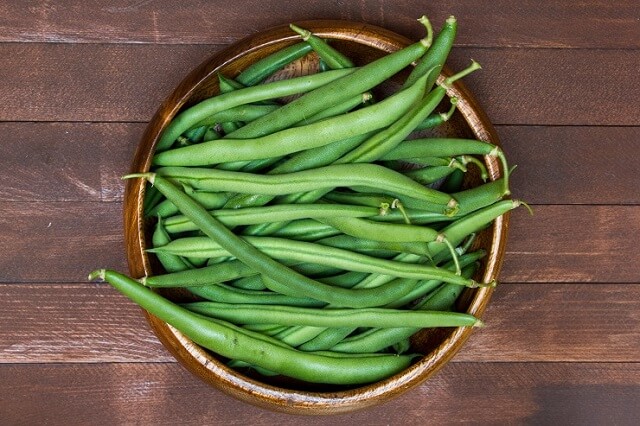
Don’t let the low calorie count fool you. Green beans are an outstanding source of many vitamins and minerals. No wonder your mom said they were good for you!
That same one-cup serving gives you approximately:
- 759 iu vitamin A
- 230 mg potassium
- 9 mg vitamin C
- .1 mg vitamin B6
- .2 mg manganese
- 5 mg magnesium
- .1 mg thiamine
- .3 mg pantothenic acid
- .1 mg copper
- 8 mg phosphorus
- 8 mcg vitamin K
- 7 mcg folate
- 7 mg calcium
- 1 mg iron
Can Guinea Pigs Have Green Beans?
Absolutely! Green beans are a pretty good snack for a guinea pig.
But before you run for the kitchen or head out to the garden, you need just a few more facts. There’s a limit to the number of green beans a guinea pig can eat and this treat is one they can’t have every day. Keep reading and in a few minutes you’ll be well-informed on the subject of green beans for guinea pigs.
Are Green Beans Good For Guinea Pigs?
Yes and no. Guinea pigs shouldn’t have too much calcium, as it binds with the oxalates in many plants and can lead to the formation of kidney stones.
Since green beans are fairly high in calcium, your guinea pig should have them in moderation.
On the other hand, green beans have lots of vitamin A and plenty of vitamin C, plus a good amount of magnesium. These are all nutrients that help guinea pigs stay healthy – and they help balance out the extra calcium.
Do Guinea Pigs Like Green Beans?
Most guinea pigs like green beans once they’ve had a nibble or two.
Keep in mind, if your piggie is a new addition to the family and hasn’t had a chance to get to know you, they might not be too keen on the idea of trying new treats right away.
Give them a little more time to settle in if they don’t seem to be interested. After a while, you might try offering your cavy green beans again to see if their opinion has changed.
How Much Green Bean Can A Guinea Pig Eat?
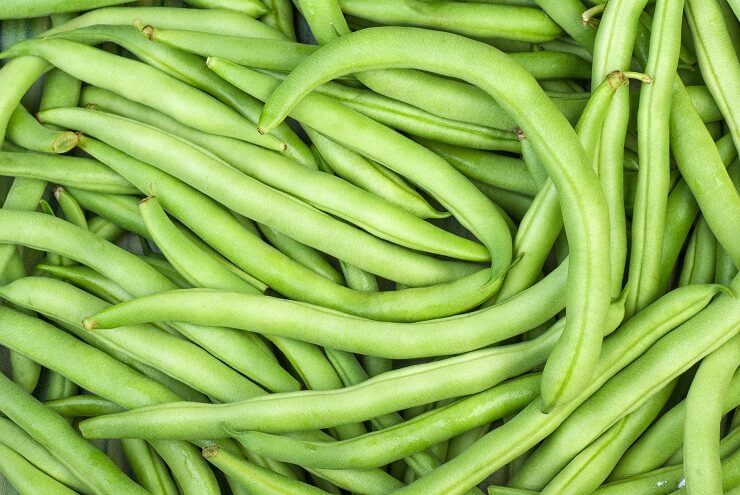
Since green beans are fairly good for guinea pigs, you might think about offering quite a few. But hold on, because moderation is the key.
Here’s how many green beans to feed your guinea pig:
| Age | Amount |
| Baby guinea pig | None |
| Adult guinea pig | 2 fresh green beans |
Two green beans might not sound terribly satisfying to you, but to your guinea pig, it’s a fairly good-sized serving.
Even though green beans are a healthy snack for your guinea pig, they can cause an upset tummy if you offer too much too soon. That’s why it’s important to make a gradual introduction and carefully increase the amount of green bean you give your guinea pig over time.
Start with about half a green bean and then observe your guinea pig for the next several hours to make sure that no bloating, discomfort, or diarrhea is happening. This isn’t likely, but it is possible!
So long as everything goes normally and your guinea pig’s poo has the right consistency, it’s fine to give them a little bit more green bean next time you’ve got it on hand.
Give your cavy one green bean the next time, one and a half beans the time after that, and the full two-bean serving after that.
This process will take several days and during that time, it’s important not to offer other new foods. Only give your piggie one new food at a time!
How Often Can A Guinea Pig Eat Green Beans?
We humans eat a lot of green beans (well, some of us do!) Even though we can have as many green beans as we want, as often as we please, guinea pigs need to have them just occasionally.
You can give your guinea pig green beans once or twice per week, but not on the same day as you offer other foods that are high in calcium.
The Correct Diet Is Important
Now that you’ve got the facts on green beans, you’re probably wondering what else guinea pigs can eat.
Lots of things! In the wild, a guinea pig’s diet is made up mostly of plants that are close to the ground – mainly grasses. To help our cavies live their best lives, we need to offer them a similar diet.
Here’s what to feed your guinea pig every day:
- As much fresh hay as they can eat, plus more for tunneling and playing in. Hay makes your guinea pig’s cage feel like home, and your piggie will have lots of fun mixing it in with their bedding.
- Guinea pig pellets fortified with vitamin C (the label will provide serving information)
- Approximately one cup of fresh vegetables each day, split into two or three smaller servings; rotate different leafy greens and crunchy veggies throughout each week to prevent oxalic acid buildup and reduce the risk of kidney stones
- An unlimited supply of clean, fresh water; remember to give your guinea pig’s drinking bottle a rinse and refill it at least once a day
What Are Other Healthy Alternatives To Green Beans In A Guinea Pig’s Diet?
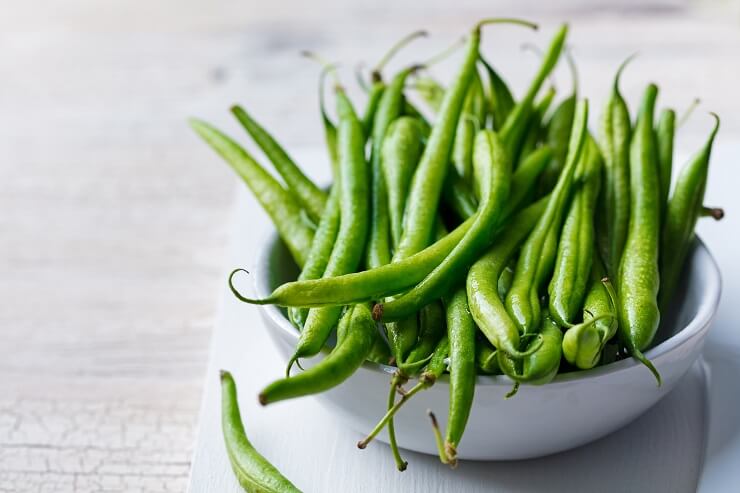
Guinea pigs need variety and they enjoy a wide array of natural foods.
Next time you’re planning your cavy’s menu, check this list for ideas:
- arugula
- swiss chard
- sweet potato
- butter lettuce
- spinach
- bell pepper
- summer squash
- winter squash
- artichoke
- parsley
- basil
- cilantro
- beets
- beet tops
- carrot
- carrot tops
- broccolini
- broccoli
- brussels sprouts
- romaine
- mint
- cabbage
- cucumber
- buttercrunch lettuce
- bibb lettuce
- escarole
- rocket
- endive
- parsnip
- zucchini
- pumpkin
- tomato
- bok choy
- asparagus
- yu choy
- watercress
Believe it or not, this list of safe vegetables for guinea pigs is just the beginning. There are lots of other options!
Just spend a few minutes researching each new item you consider for your cavy. This way, you’ll know if items are safe plus you’ll be able to find out how much they can have.
Now that you’re in the know, it’s time for some fun!
Giving your guinea pig green beans is a great way to add some variety to their diet and make their day just a little tastier.
Frequently Asked Questions
Are green beans safe for guinea pigs?
Yes, so long as you remember to offer the recommended serving and introduce them gradually.
Can green beans make my guinea pig sick?
Yes. While it isn’t very likely, there’s a chance that green beans could give your guinea pig some digestive trouble or diarrhea. You should be able to prevent this by gradually getting your cavy’s digestive system accustomed to green beans over time!
Can guinea pigs have cooked green beans?
No, cooked foods aren’t appropriate for cavies. Guinea pigs cannot eat cooked green beans because their digestive systems can only handle raw or dried foods.
Can guinea pigs eat frozen green beans?
No, frozen green beans have been blanched (lightly cooked) before freezing and during the thawing process, bacteria can accumulate.
It’s not worth the risk. Only give a cavy fresh green beans.
Can guinea pigs eat canned green beans?
No. Canned green beans are cooked and they’re very salty, so they’re not safe (or good) for your guinea pig.






